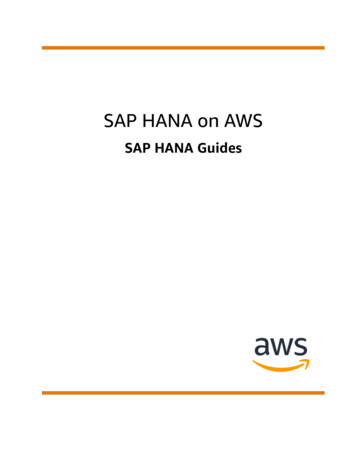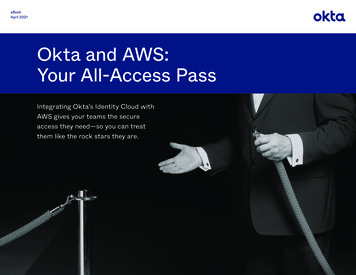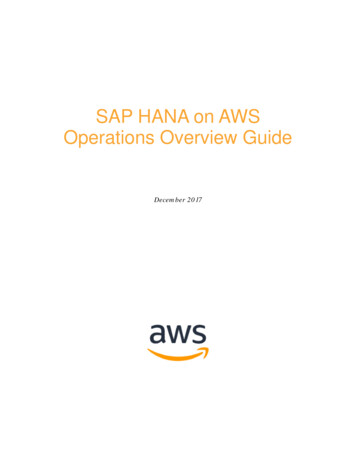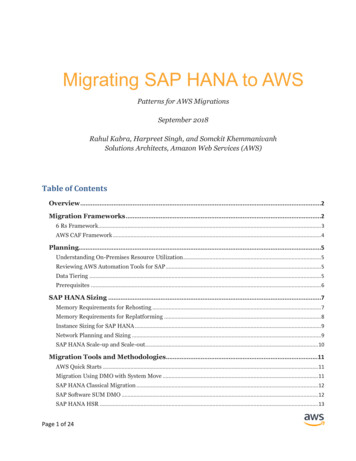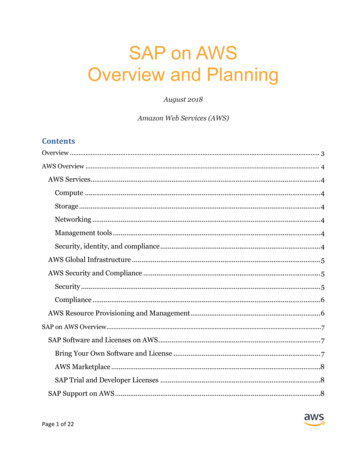
Transcription
SAP on AWSOverview and PlanningAugust 2018Amazon Web Services (AWS)ContentsOverview . 3AWS Overview . 4AWS Services. 4Compute . 4Storage . 4Networking . 4Management tools . 4Security, identity, and compliance . 4AWS Global Infrastructure . 5AWS Security and Compliance . 5Security . 5Compliance .6AWS Resource Provisioning and Management .6SAP on AWS Overview . 7SAP Software and Licenses on AWS . 7Bring Your Own Software and License . 7AWS Marketplace .8SAP Trial and Developer Licenses .8SAP Support on AWS .8Page 1 of 22
SAP on AWS Technical Content – SAP on AWS Overview and PlanningAugust 2018SAP Solutions Supported on AWS .8SAP Support on AWS .9Deploying SAP Systems on AWS . 9Manual Installation Using SAP Standard Installation Process .9Automated Deployment Using AWS Quick Starts . 10Rapid Provisioning Using Prebuilt SAP Images . 10Getting Assistance from AWS Partners . 10Partner Services for SAP on AWS . 10Types of Partner Services and Solutions for SAP on AWS . 10How to Find Partner Services and Solutions for SAP on AWS.11SAP on AWS Planning . 12SAP Notes . 12Choosing an Architecture . 12All-on-AWS Architecture . 13Hybrid AWS Architecture . 14Choosing an AWS Region and Availability Zone. 15Choosing a Region . 15Choosing an Availability Zone. 15Configuring Network and Connectivity . 15Amazon VPC . 15Network Connectivity Options . 16Following Security Best Practices . 16Shared Responsibility Environment . 17Amazon VPC . 17Choosing Instance Types . 17General Information. 18For SAP NetWeaver-based Solutions. 18For SAP HANA . 18Page 2 of 22
SAP on AWS Technical Content – SAP on AWS Overview and PlanningAugust 2018For SAP Business One, Edition for SAP HANA . 18Supported Operating Systems . 18Operating Systems. 18Operating System Licenses . 19Supported Databases . 19Database Installation and Administration . 19Database Licenses . 20SAP Installation Media . 20Setting up SAProuter and SAP Solution Manager . 21For SAP All-on-AWS Architecture . 21For SAP Hybrid AWS Architecture . 21Document Revisions . 21OverviewThis guide provides overview and planning information for SAP customers and partnerswho are considering implementing or migrating SAP environments or systems to theAmazon Web Services (AWS) Cloud.This guide is intended for users who have previous experience installing, migrating, andoperating SAP environments and systems on traditional on-premises infrastructure. Itconsists of three main sections: An overview of the AWS Cloud and AWS services, for readers who are new to the cloud. An overview of SAP on AWS, including software and licenses, support options, andpartner services. Technical considerations that will help you plan and get the most out of your SAPenvironment on AWS.Note To access the SAP notes referenced in this guide, you must have an SAP OneSupport Launchpad user account.Page 3 of 22
SAP on AWS Technical Content – SAP on AWS Overview and PlanningAugust 2018AWS OverviewAWS offers a broad set of global, cloud-based services, including compute, storage,databases, analytics, networking, mobile, developer tools, management tools, Internet ofThings (IoT), security, and management tools. These services help organizations movefaster, lower IT costs, and support scalability. AWS is trusted by the largest enterprises andpopular start-ups to power a wide variety of workloads, including web and mobileapplications, game development, data processing and warehousing, storage, and archiving.AWS ServicesAWS provides over 120 cloud services that you can use in combinations tailored to yourbusiness or organizational needs. This section introduces the AWS services that are mostrelevant for the installation and operation of SAP solutions. For an overview of each serviceand to learn about its features, pricing, and documentation, follow the link in this list.Compute Amazon Elastic Compute Cloud (Amazon EC2)Storage Amazon Elastic Block Store (Amazon EBS) Amazon Simple Storage Service (Amazon S3) Amazon Elastic File System (Amazon EFS)Networking Amazon Virtual Private Cloud (Amazon VPC) Amazon Route 53 AWS Direct ConnectManagement tools AWS Management Console AWS Command Line Interface AWS CloudFormation Amazon CloudWatchSecurity, identity, and compliance AWS Identity and Access ManagementPage 4 of 22
SAP on AWS Technical Content – SAP on AWS Overview and PlanningAugust 2018For information about all AWS services, see the Overview of Amazon Web Serviceswhitepaper.AWS Global InfrastructureThe AWS Cloud infrastructure is built around Regions and Availability Zones. An AWSRegion is a physical location that provides multiple, physically separated and isolatedAvailability Zones. Each Availability Zone consists of one or more data centers that areconnected with low-latency, high-throughput, and highly redundant networking. TheseAvailability Zones offer an easier and more effective way to design and operate yourapplications and databases, making them more highly available, fault tolerant, and scalablethan traditional single or multiple data center infrastructures.For a list of the available AWS Regions and to learn more about the AWS globalinfrastructure, see Global Infrastructure on the AWS website.AWS Security and ComplianceSecurityCloud security at AWS is the highest priority. As an AWS customer, you will benefit from adata center and network architecture built to meet the requirements of the most securitysensitive organizations. Security in the cloud is much like security in your on-premises datacenters—only without the costs of maintaining facilities and hardware. In the cloud, youdon’t have to manage physical servers or storage devices. Instead, you use software-basedsecurity tools to monitor and protect the flow of information into and out of your cloudresources.As an AWS customer you inherit all the best practices of AWS policies, architecture, andoperational processes built to satisfy the requirements of our most security-sensitivecustomers, and get the flexibility and agility you need in security controls.The AWS Cloud enables a shared responsibility model. While AWS manages security of thecloud, you are responsible for security in the cloud. This means that you retain control ofthe security you choose to implement to protect your own content, platform, applications,systems, and networks no differently than you would in an on-site data center.To learn more about AWS security, see AWS Cloud Security on the AWS website.Page 5 of 22
SAP on AWS Technical Content – SAP on AWS Overview and PlanningAugust 2018ComplianceAWS provides robust controls to help maintain security and data protection in the cloud. Assystems are built on top of AWS Cloud infrastructure, compliance responsibilities will beshared. By tying together governance-focused, audit-friendly service features withapplicable compliance or audit standards, AWS Compliance enablers build on traditionalprograms and help you operate in an AWS security control environment.The IT infrastructure that AWS provides to its customers is designed and managed inalignment with best security practices and a variety of IT security standards. The followingis a partial list of assurance programs with which AWS complies: SOC 1/ISAE 3402, SOC 2, SOC 3FISMA, DIACAP, and FedRAMPPCI DSS Level 1ISO 9001, ISO 27001, ISO 27018To learn more about AWS compliance, visit AWS Cloud Compliance on the AWS website.AWS Resource Provisioning and ManagementThe provisioning and management of AWS services and resources use a self-service modelmanaged by the customer or a partner. For an overview of the tools available forprovisioning and management, see Management Tools in the AWS Services section.Figure 1 shows the services managed by AWS and the services managed by the customer orpartner for SAP.Page 6 of 22
SAP on AWS Technical Content – SAP on AWS Overview and PlanningAugust 2018Figure 1: Managed services for SAP on AWSSAP on AWS OverviewAWS has been working with SAP since 2011 to enable customers to deploy and migratetheir SAP applications to AWS, and SAP has certified AWS for the vast majority of SAPapplications available to customers today. In addition, AWS is working with SAP to powermultiple SaaS services and offerings, including SAP Concur, SAP SuccessFactors, SAPCloud Platform, and SAP HANA Enterprise Cloud.SAP Software and Licenses on AWSThis section describes the options available for SAP software and licenses on AWS.Bring Your Own Software and LicenseThe majority of SAP solutions that can be run on AWS use a bring-your-own-software andbring-your-own-license (BYOL) model. Running SAP systems on AWS doesn’t requirespecial or new SAP licenses. If you’re an existing SAP customer, you can use your existingSAP licenses when running SAP on AWS. You are responsible for obtaining a valid SAPlicense, and you must ensure that you are in compliance with the SAP licensing policies.AWS does not provide or sell SAP licenses.Page 7 of 22
SAP on AWS Technical Content – SAP on AWS Overview and PlanningAugust 2018AWS MarketplaceAWS Marketplace is a digital catalog with thousands of software listings from independentsoftware vendors that makes it easy to find, test, buy, and deploy software that runs onAWS. To view SAP-related offerings available in AWS Marketplace, follow this link: SAP inAWS Marketplace.SAP Trial and Developer LicensesThe SAP Cloud Appliance Library provides access to an online repository of the latestpreconfigured SAP solutions. You can instantly install these solutions on AWS by using alaunch wizard that automates deployment. Some of the solutions available in the SAP CloudAppliance Library are provided with free trial or developer edition licenses.SAP Hardware Key GenerationSAP hardware key generation on EC2 instances uses a specific process that is dependent onthe SAP kernel patch level. If a hardware key is generated before patching the SAP kernel tothe proper level, and the kernel is updated at a later time, the hardware key may change,making the installed license invalid. For details on how the SAP hardware ID is generatedon EC2 instances and the required SAP kernel patch levels see the following SAP notes(SAP One Support Launchpad access required): SAP Note 1178686 - Linux: Alternative method to generate a SAP hardware key SAP Note 2327159 - SAP NW License Behavior in Virtual and Cloud Environments SAP Note 1697114 - Determination of hardware ID In Amazon clouds SAP Note 2113263 - Additional public key for AWS Hardware ID SAP Note 2319387 - Adjustment of the license check for AWS ChinaSAP Support on AWSAWS and SAP have worked together closely to ensure that you will receive the same level ofsupport and can use the same support channels, whether you’re running your SAP systemson AWS or on premises.SAP Solutions Supported on AWSThe majority of SAP solutions that can run on traditional on-premises infrastructure arefully supported by SAP to run in production on AWS. For the complete list of SAP solutionssupported on AWS, see SAP Note 1656099 and the other notes referenced within that note.Page 8 of 22
SAP on AWS Technical Content – SAP on AWS Overview and PlanningAugust 2018SAP Support on AWSTo obtain support for SAP environments and systems running on AWS, you can followSAP’s standard support process.To receive full support, see SAP Note 1656250 for a few requirements for running SAPsystems on AWS. One of the primary requirements is to enable the built-in SAP monitors toretrieve information about configuration and resource utilization from the underlying AWSinfrastructure. There are two steps to enable SAP monitoring on AWS: Enable detailed monitoring for Amazon CloudWatch on each EC2 instance toensure that the required AWS metrics are provided in one-minute intervals. Foradditional information on Amazon CloudWatch, seehttp://aws.amazon.com/cloudwatch. Install, configure, and run the AWS Data Provider for SAP on each EC2 instance.The AWS Data Provider collects the required performance and configuration datafrom a variety of sources, including the Amazon EC2 API, Amazon EC2 instancemetadata, and Amazon CloudWatch. For detailed installation instructions, see theAWS Data Provider Installation and Operations Guide and SAP Note 1656250.Deploying SAP Systems on AWSThe section describes the different options available for provisioning AWS infrastructureand installing SAP systems on AWS.Manual Installation Using SAP Standard Installation ProcessThe majority of SAP solutions supported on AWS can be installed by manually provisioningthe required AWS infrastructure resources and then following the relevant, standard SAPinstallation documentation to install the SAP system on AWS.The following SAP solutions use a manual SAP installation process on AWS: SAP Business Suite and NetWeaver-based solutions SAP HANA SAP BusinessObjects Business Intelligence (BI) SAP Hybris Commerce SAP Business OnePage 9 of 22
SAP on AWS Technical Content – SAP on AWS Overview and PlanningAugust 2018Automated Deployment Using AWS Quick StartsAWS Quick Starts are built by AWS solutions architects and partners to help you deploypopular solutions on AWS, based on AWS best practices for security and high availability.These reference deployments implement key technologies automatically on the AWS Cloud,and eliminate many of the manual steps required for deployment. You can build your testor production environment in a few steps, and start using it immediately.The following AWS Quick Starts for SAP are currently available: SAP HANA SAP NetWeaver SAP Business One, version for SAP HANARapid Provisioning Using Prebuilt SAP ImagesSome SAP solutions are available on AWS as a prebuilt system image that contains apreinstalled and preconfigured SAP system. A prebuilt SAP system image enables you torapidly provision a new SAP system without spending the time and effort required by atraditional manual SAP installation.Prebuilt SAP system images are available from the following sources: AWS Marketplace SAP Cloud Appliance LibraryGetting Assistance from AWS PartnersAWS has experienced SAP partners who can build a complete SAP environment or a singleSAP system for you. For additional information see the following section.Partner Services for SAP on AWSThe AWS Partner Network (APN) is a community of companies that offer a wide range ofservices and products on AWS. APN SAP partners can provide SAP-specific services to helpyou fully maximize the benefits of running SAP solutions on AWS.Types of Partner Services and Solutions for SAP on AWSCloud assessment servicesAdvisory services to help you develop an efficient and effective plan for your cloudadoption journey. Typical services include financial/TCO (total cost of ownership),technical, security and compliance, and licensing.Page 10 of 22
SAP on AWS Technical Content – SAP on AWS Overview and PlanningAugust 2018Proof-of-concept servicesServices to help you test SAP on AWS; for example: SAP ERP/ECC migration to SAPHANA or S/4HANA, SAP Business Warehouse (BW) migration to SAP HANA orBW/4HANA, SAP OS/DB migrations, new SAP solution implementation.Migration servicesServices to migrate existing SAP environments or systems to AWS; for example: allon-AWS SAP migrations (PRD/QAS/DEV), hybrid SAP migrations (QAS/DEV), singleSAP system (e.g., SAP BW) migrations.Managed servicesManaged services for SAP environments on AWS, including: AWS account andresource administration, OS administration/patching, backup and recovery, SAP Basisand NetWeaver.Packaged solutionsBundled software and service offerings from SAP Partners that combine SAP software,licenses, implementation, and managed services on AWS, such as SAP S/4HANA, SAPBusinessObjects BI, and many others.Software solutionsPartner software solutions for the migration, integration, and operation of SAPsolutions on AWS; for example: system migration, high availability, backup andrecovery, data replication, automatic scaling, disaster recovery.How to Find Partner Services and Solutions for SAP on AWSThe AWS SAP Partner Services and Solutions Directory provides a centralizedplace to search, discover, and connect with trusted APN partners who offer solutions andservices to help your business achieve faster time to value and maximize the benefits ofrunning SAP solutions on AWS. The AWS SAP Partner Services and Solutions Directory canbe found on the AWS website at the following path:https:/aws.amazon.com/sap - Partners - Find a PartnerPage 11 of 22
SAP on AWS Technical Content – SAP on AWS Overview and PlanningAugust 2018Figure 2: Accessing the AWS SAP Partner Services and Solutions DirectorySAP on AWS PlanningIf you are an experienced SAP Basis or NetWeaver administrator, there are a number ofAWS-specific considerations relating to compute configurations, storage, security,management, and monitoring that will help you get the most out of your SAP environmenton AWS. This section provides guidelines for achieving optimal performance, availability,and reliability, and lower total cost of ownership (TCO) while running SAP solutions onAWS.SAP NotesBefore migrating or implementing an SAP environment or system on AWS, you should readand follow the relevant SAP on AWS SAP Notes. Start from SAP Note 1656099 for generalinformation and follow the links to other relevant SAP notes. Access to SAP notes requiresan SAP One Support Launchpad user account.Choosing an ArchitectureThis section describes the two primary architectural patterns for SAP on AWS: all systemson AWS and hybrid.Page 12 of 22
SAP on AWS Technical Content – SAP on AWS Overview and PlanningAugust 2018All-on-AWS ArchitectureWith the SAP All-on-AWS architecture, all systems and components of your SAPenvironment are hosted on AWS. Example scenarios of this architecture include: Implementation of a complete, new SAP environment on AWS Migration of a complete, existing SAP environment to AWSFigure 3 depicts an SAP all-on-AWS architecture. The SAP environment running on AWS isintegrated with on-premises systems and users via a VPN connection or a dedicatednetwork connection via AWS Direct Connect. SAProuter is deployed in a public subnet andassigned a public IP address that is reachable from the internet to enable integration withthe SAP OSS network via a virtual network computing (VNC) connection. A networkaddress translation (NAT) gateway enables instances in the private subnet to connect to theinternet or other AWS services, but prevents instances from receiving inbound traffic that isinitiated by someone on the internet. For additional information, see the ConfiguringNetwork and Connectivity section.Figure 3: SAP all-on-AWS architecturePage 13 of 22
SAP on AWS Technical Content – SAP on AWS Overview and PlanningAugust 2018Hybrid AWS ArchitectureWith an SAP hybrid AWS architecture, some SAP systems and components are hosted onyour own, on-premises infrastructure and others are hosted on the AWS infrastructure.Example scenarios of this architecture include: Running SAP test, trial, training, PoC, and similar systems on AWS Running non-production SAP landscapes (for example, DEV and QAS) on AWS,integrated with an SAP production landscape running on premises Implementing a new SAP application on AWS and integrating it with an existingSAP on-premises environmentFigure 4 depicts an SAP hybrid AWS architecture with SAP DEV and QAS landscapes andSAP test, training, and PoC systems running on AWS. These systems are integrated withSAP systems and users on the corporate network. Connectivity between the VPC and thecorporate network is provided with either a VPN connection or an AWS Direct Connectconnection. The existing SAProuter and SAP Solution Manager running on the corporatenetwork are used to manage the SAP systems running within the VPC.Figure 4: SAP hybrid AWS architecturePage 14 of 22
SAP on AWS Technical Content – SAP on AWS Overview and PlanningAugust 2018Choosing an AWS Region and Availability ZoneSee the AWS Global Infrastructure section of this guide for information about AWS Regionsand Availability Zones.Choosing a RegionConsider the following factors when deciding which AWS Region to deploy your SAPenvironment in: Choose a region that is close to your data center or corporate network. This will reducenetwork latency between systems running on AWS and systems and users on yourcorporate network. Make sure that the AWS services and instance types you require are available in theregion. For a detailed list of AWS products and services by region, see the region tablesin the AWS documentation.Choosing an Availability ZoneNo special considerations are required when choosing an Availability Zone for your SAPdeployment on AWS. All SAP applications (SAP ERP, CRM, SRM, and so on) and systems(SAP DB, SAP CI, application servers) should be deployed in the same Availability Zone. Ifhigh availability (HA) is a requirement, use multiple Availability Zones. For moreinformation about high availability, see the SAP on AWS High Availability Guide.Configuring Network and ConnectivityAmazon VPCAmazon VPC enables you to define a virtual network in your own, logically isolated areawithin the AWS Cloud. You can launch your AWS resources, such as instances, into yourVPC. Your VPC closely resembles a traditional network that you might operate in your owndata center, with the benefits of using the AWS scalable infrastructure. You can configureyour VPC; you can select its IP address range, create subnets, and configure route tables,network gateways, and security settings. You can connect instances in your VPC to theinternet. You can connect your VPC to your own corporate data center, and make the AWSCloud an extension of your data center. To protect the resources in each subnet, you can usemultiple layers of security, including security groups and network access control lists. Formore information, see the Amazon VPC User Guide.For detailed instructions for setting up and configuring a VPC and the connection betweenyour network and VPC, see the Amazon VPC documentation.Page 15 of 22
SAP on AWS Technical Content – SAP on AWS Overview and PlanningAugust 2018Network Connectivity OptionsMultiple options are available to provide network connectivity between your on-premisesusers and systems with your SAP systems running on AWS, including a direct internetconnection, hardware VPN, and private network connection.Direct Internet ConnectionThe quickest and simplest way to connect to your SAP systems running on AWS involvesusing a VPC with a single public subnet and an internet gateway to enable communicationover the internet. For additional information, see Scenario 1: VPC with a Public SubnetOnly in the Amazon VPC User Guide.Use cases: Most suitable for SAP demo, training, and test type systems.Hardware VPNAn industry-standard, encrypted IPsec hardware site-to-site VPN connection between yournetwork and VPC. For additional information, see Adding a Hardware Virtual PrivateGateway to your VPC in the Amazon VPC User Guide.Use cases: Recommended for any SAP environments on AWS that require integrationwith on-premises users and systems.Private Network ConnectionA dedicated, private network connection between your network and one of the AWS DirectConnect locations, using industry standard 802.1Q VLANs. For additional information, seethe AWS Direct Connect User Guide.Use cases: Recommended for customers who require greater bandwidth and lowerlatency than possible with a hardware VPN.For additional information about the different Amazon VPC connectivity options, see theAmazon Virtual Private Cloud Connectivity Options whitepaper.Following Security Best PracticesIn order to provide end-to-end security and end-to-end privacy, AWS builds services inaccordance with security best practices, provides appropriate security features in thoseservices, and documents how to use those features. In addition, AWS customers must usethose features and best practices to architect an appropriately secure applicationenvironment. Enabling customers to ensure the confidentiality, integrity, and availability oftheir data is of the utmost importance to AWS, as is maintaining trust and confidence.Page 16 of 22
SAP on AWS Technical Content – SAP on AWS Overview and PlanningAugust 2018Shared Responsibility EnvironmentThere is a shared responsibility model between you as the customer and AWS. AWSoperates, manages, and controls the components from the hos
SAP on AWS Technical Content – SAP on AWS Overview and Planning August 2018 Page 4 of 22 AWS Overview AWS offers a broad set of global, cloud-based services, including compute, storage, databases, analytics, networkin


